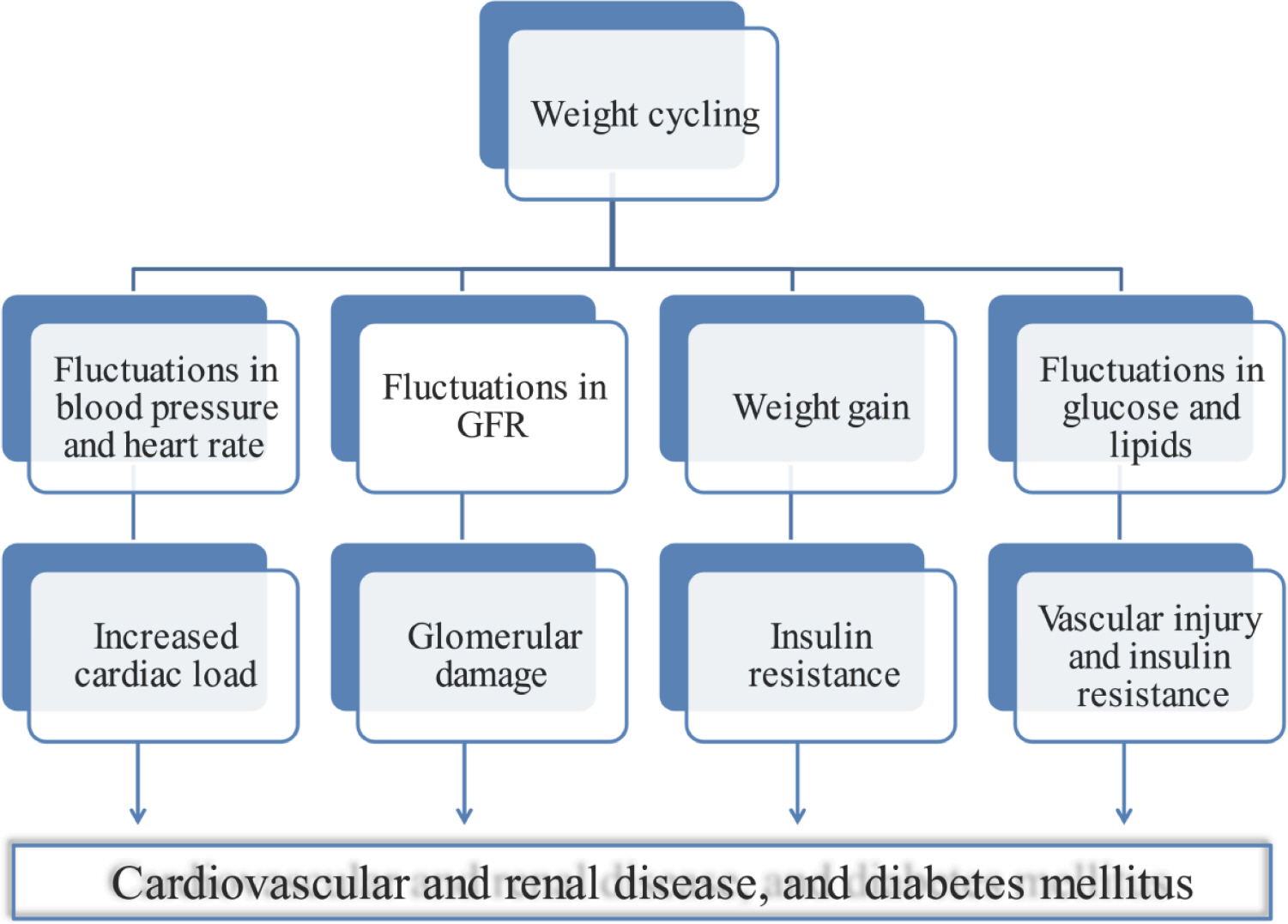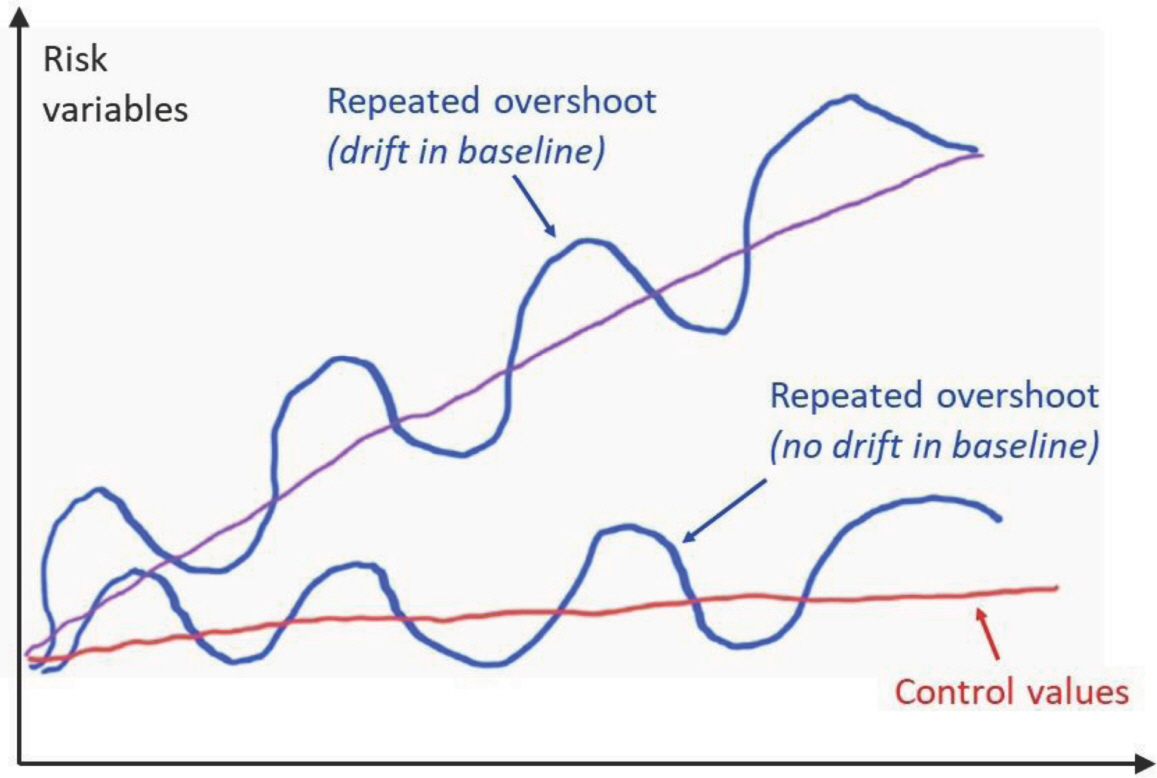2.Jarolimova J, Tagoni J, Stern TA. Obesity: its epidemiolo-gy, comorbidities, and management. Prim Care Companion CNS Disord 2013 15:PCC.12f01475.

3.Gallagher EJ, LeRoith D. Obesity and diabetes: the in-creased risk of cancer and cancer-related mortality. Physi-ol Rev 2015;95:727-48.

7.Montani JP, Schutz Y, Dulloo AG. Dieting and weight cycling as risk factors for cardiometabolic diseases: who is really at risk? Obes Rev 2015;16(Suppl 1):7-18.


8.Dwyer JT, Mayer J. Potential dieters: who are they? J Am Diet Assoc 1970;56:510-4.

12.Yaemsiri S, Slining MM, Agarwal SK. Perceived weight status, overweight diagnosis, and weight control among US adults: the NHANES 2003-2008 Study. Int J Obes (Lond) 2011;35:1063-70.


13.Lahti-Koski M, Seppänen-Nuijten E, Männistö S, Härkänen T, Rissanen H, Knekt P, et al. Twenty-year changes in the prevalence of obesity among Finnish adults. Obes Rev 2010;11:171-6.


15.Mason EE. Methods for voluntary weight loss and control. NIH Technology Assessment Conference Panel. Consen-sus Development Conference, 30 March to 1 April 1992. Ann Intern Med 1993;119(7 Pt 2):764-70.


16.Mann T, Tomiyama AJ, Westling E, Lew AM, Samuels B, Chatman J. Medicare's search for effective obesity treatments: diets are not the answer. Am Psychol 2007;62:220-33.


17.Montani JP, Viecelli AK, Prévot A, Dulloo AG. Weight cycling during growth and beyond as a risk factor for later cardiovascular diseases: the ‘repeated overshoot' theory. Int J Obes (Lond) 2006 30(Suppl 4):S58-66. Erratum in: Int J Obes (Lond) 2010;34:1230.


18.Foreyt JP, Brunner RL, Goodrick GK, Cutter G, Brownell KD, St Jeor ST. Psychological correlates of weight fluctuation. Int J Eat Disord 1995;17:263-75.


19.Field AE, Byers T, Hunter DJ, Laird NM, Manson JE, Williamson DF, et al. Weight cycling, weight gain, and risk of hypertension in women. Am J Epidemiol 1999;150:573-9.


20.Atkinson RL, Dietz WH, Foreyt JP, Goodwin NJ, Hill JO, Hirsch J, et al. Weight cycling: National task force on the prevention and treatment of obesity. JAMA 1994;272:1196-202.


22.Bendixen H, Madsen J, Bay-Hansen D, Boesen U, Ovesen LF, Bartels EM, et al. An observational study of slimming behavior in Denmark in 1992 and 1998. Obes Res 2002;10:911-22.


25.Currie C, Zanotti C, Morgan A, Currie D, de Looze M, Roberts C, et alSocial determinants of health and well-being among young people. Health Behaviour in School-aged Children (HBSC) Study: International Re-port from the 2009/2010 Survey. Denmark: WHO Re-gional Office for Europe; 2012.
26.Marshall C, Lengyel C, Utioh A. Body dissatisfaction among middle-aged and older women. Can J Diet Pract Res 2012;73:e241-7.


27.Koutedakis Y, Jamurtas A. The dancer as a performing athlete: physiological considerations. Sports Med 2004;34:651-61.

28.Cole E, Rothblum ED, Thone RRFat: a fate worse than death? Women, weight, and appearance. New York: Ha-worth Press Inc.; 1997.
29.Sundgot-Borgen J, Meyer NL, Lohman TG, Ackland TR, Maughan RJ, Stewart AD, et al. How to minimise the health risks to athletes who compete in weight-sensitive sports review and position statement on behalf of the Ad Hoc Research Working Group on Body Composition, Health and Performance, under the auspices of the IOC Medical Commission. Br J Sports Med 2013;47:1012-22.


30.Bosy-Westphal A, Kahlhöfer J, Lagerpusch M, Skurk T, Müller MJ. Deep body composition phenotyping during weight cycling: relevance to metabolic efficiency and metabolic risk. Obes Rev 2015;16(Suppl 1):36-44.


31.Zhang H, Tamakoshi K, Yatsuya H, Murata C, Wada K, Otsuka R, et al. Long-term body weight fluctuation is associated with metabolic syndrome independent of current body mass index among Japanese men. Circ J 2005;69:13-8.


32.Saarni SE, Rissanen A, Sarna S, Koskenvuo M, Kaprio J. Weight cycling of athletes and subsequent weight gain in middleage. Int J Obes (Lond) 2006;30:1639-44.


33.Korkeila M, Rissanen A, Kaprio J, Sorensen TI, Koskenvuo M. Weight-loss attempts and risk of major weight gain: a prospective study in Finnish adults. Am J Clin Nutr 1999;70:965-75.


34.Pietiläinen KH, Saarni SE, Kaprio J, Rissanen A. Does dieting make you fat? A twin study. Int J Obes (Lond) 2012;36:456-64.


35.Yatsuya H, Tamakoshi K, Yoshida T, Hori Y, Zhang H, Ishikawa M, et al. Association between weight fluctuation and fasting insulin concentration in Japanese men. Int J Obes Relat Metab Disord 2003;27:478-83.


36.Kakinami L, Knäuper B, Brunet J. Weight cycling is associated with adverse cardiometabolic markers in a cross-sectional representative US sample. J Epidemiol Community Health 2020;74:662-7.


38.Antic V, Dulloo A, Montani JP. Short-term (5-day) changes in food intake alter daily hemodynamics in rabbits. Am J Hypertens 2003;16:302-6.


39.Cereda E, Malavazos AE, Caccialanza R, Rondanelli M, Fatati G, Barichella M. Weight cycling is associated with body weight excess and abdominal fat accumulation: a cross-sectional study. Clin Nutr 2011;30:718-23.


40.Bosy-Westphal A, Schautz B, Lagerpusch M, Pourhassan M, Braun W, Goele K, et al. Effect of weight loss and regain on adipose tissue distribution, composition of lean mass and resting energy expenditure in young overweight and obese adults. Int J Obes (Lond) 2013;37:1371-7.


41.Byrne NM, Weinsier RL, Hunter GR, Desmond R, Pat-terson MA, Darnell BE, et al. Influence of distribution of lean body mass on resting metabolic rate after weight loss and weight regain: comparison of responses in white and black women. Am J Clin Nutr 2003;77:1368-73.


45.Peters ET, Seidell JC, Menotti A, Arayanis C, Dontas A, Fidanza F, et al. Changes in body weight in relation to mortality in 6441 European middle-aged men: the Seven Countries Study. Int J Obes Relat Metab Disord 1995;19:862-8.

46.Neamat-Allah J, Barrdahl M, Hüsing A, Katzke VA, Bachlechner U, Steffen A, et al. Weight cycling and the risk of type 2 diabetes in the EPIC-Germany cohort. Dia-betologia 2015;58:2718-25.

47.Zou H, Yin P, Liu L, Duan W, Li P, Yang Y, et al. Association between weight cycling and risk of developing diabetes in adults: a systematic review and meta-analysis. J Diabetes Investig 2021;12:625-32.


48.Rhee EJ, Cho JH, Kwon H, Park SE, Park CY, Oh KW, et al. Increased risk of diabetes development in individuals with weight cycling over 4 years: The Kangbuk Samsung Health study. Diabetes Res Clin Pract 2018;139:230-8.







